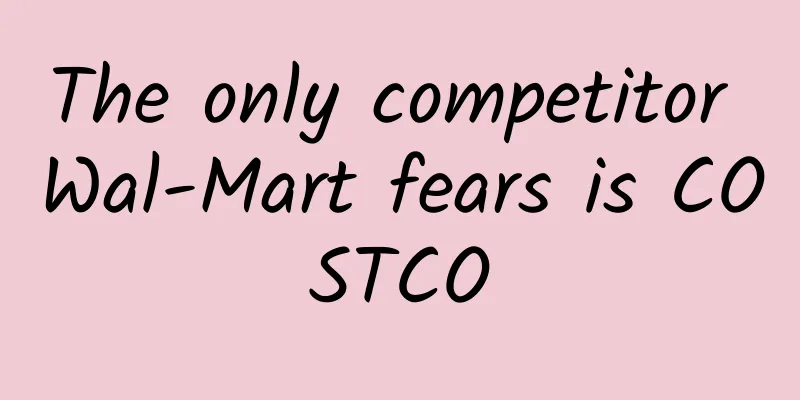|
Costco has never had a negative monthly sales growth, and the average sales per store is $105 million. These are miracles created by Costco. Therefore, it is called: "The only rival Wal-Mart is afraid of."
Retail enterprises limit their gross profit margin to 14%? Retail enterprises limit the number of products they sell to no more than 4,000? Consumers must pay to enter the store to consume? Before Costco, anyone who raised these questions would be laughed at: only fools would do this! But Jim Hingley, CEO of Costco, did it. It is precisely because of the unconventional business philosophy that Costco has continued to expand and become a legend in the retail industry. The origin of Costco As of 2006, Costco has gone through 23 years of history, but Chinese people are generally unfamiliar with it - this company with 488 stores worldwide has not yet entered mainland China. The reason why it is called a wealth hunter is that it has a unique global warehouse sales model. However, this model is not its original creation, but was born out of the Price i8 Club, which was a powerful price membership store in the US retail industry more than 30 years ago - Jim, the current CEO of Costco, worked in it for nearly 20 years, growing from a mattress loader to the manager of the head office. Although Jim's work at the Price Club was hard and complicated, he learned a lot from his boss, Sol Price, which was later passed on to Costco without exception. Price had a set of unconventional ideas for the retail industry: Price Club did not advertise, did not accept the most popular credit cards, and only members could enter the store to shop. The biggest subversion of Jim's inherent sales philosophy came from Price's strict restrictions on profits and his refusal to get any extra money from consumers. Under Price's influence, Jim also became a master of the art of retail. "Right time, right quality, right place, right price" was the most basic and boring principle in the retail industry, but in his hands, it was played brilliantly. Finally, in 1983, Jim resigned from the Price Club and founded Costco in partnership with Jeff Brotman (current chairman of Costco). One of the interesting episodes was that when Jim told Price that he was also going to set up a warehouse sales club and might become a competitor to the Price Club, Price did not take it seriously. But soon Price realized that the employees he had trained had become his strongest competitors. Ten years later, in 1993, Price Club and Costco merged. Costco has achieved remarkable results worldwide: since its establishment, its affiliated stores have never experienced negative monthly sales growth; it is currently the fourth largest retailer in the United States and ranks seventh among global retailers; in 2005, the total sales revenue of 488 stores worldwide was US$59 billion, ranking 28th among the Fortune 500 companies. Unlike other peers who pursue cheapness, such as Wal-Mart and Target, Costco's products vary in grade. Its customers may have a diamond ring worth $50,000 and a huge 64-ounce barrel of mayonnaise in their carts at the same time. Currently, Costco has about 48 million members worldwide. These members are not only loyal to Costco like "slaves" (according to UBS, Costco members go to the store 22 times a year on average), but also spend unexpectedly high amounts each time. Costco has always maintained its position as the leader among membership warehouse stores. Although it had 82 fewer stores than Wal-Mart's Sam's Club by 2006, Costco's sales revenue was still $20 billion higher than its rival. According to a set of sales data in 2003, Costco's average sales per store was $105 million (the average for domestic stores in the United States was $112 million), nearly twice that of Wal-Mart's Sam's Club ($58.9 million). More importantly, Costco's average sales growth rate per store was 6%, while Sam's Club's was 2.2%. It is for these reasons that Costco has always been considered "the only company Wal-Mart is afraid of" in the United States, ranks among the top in the evaluation of the US customer satisfaction index, and has won the annual award of the National Discount Merchants (DM) many times. All these prove that Costco has a correct set of business policies. Costco's tricks As mentioned earlier, Costco implements a membership system, and consumers can only enter the store to consume if they become members. To become a member of Costco, you need to pay a membership fee of $55 (general member) or $100 (gold card member) per year (in 2006 alone, Costco's membership fee income reached $1.1 billion). At the same time, more than one-third of Costco's members have an annual household income of more than $75,000, making them middle class. They spend an average of $10,000 to $20,000 per year at Costco, which is why Costco's performance remains high. However, what makes these smart and wealthy people so crazy about Costco? Everything has to be analyzed from Costco's business model. Low profits First, Costco uses the cost-plus method to set prices and limit its profits. The gross profit is not allowed to exceed 14%, and the pre-tax profit is 3%. In fact, low profits and quick turnover is the way Costco makes money, which can be seen from the following table. Annual sales per square foot of company stores (US dollars) Target 307 Nordstrom 369 Home Depot 377 Wal-Mart* 438 BJ's 445 Sam's Club* 552 Costco 918 Best Buy 941 For example, in 2006, Costco tried mooncakes in its Ottawa store. The total weight of the 750-gram, 4-pack of white lotus seed paste mooncakes made in Macau with double yolks was only 10.49 Canadian dollars, which caused quite a stir in the local Chinese community. The 3,000 boxes of mooncakes that arrived were sold out within two days. Based on the highest profit margin of 14%, the gross profit income of this batch of mooncakes was only 4,406 Canadian dollars, which is not a large amount, but what if all the products were sold at this speed? In addition, Costco always pays attention to the gap between itself and its competitors in sales pricing. A few years ago, Costco bought a pair of jeans from a well-known brand that was sold at $50 in department stores. Since the purchase price was quite cheap, it could have set a higher price, but in the end Costco set the price at $29.9. You can imagine how popular it was in the market. It is worth mentioning that for high-end brands such as Waterfords and Calvin Kleins, discounts are not an effective marketing strategy, but Costco still insists on selling these products in its own way, legally trying to get these high-end products into the gray area of discount sales. Therefore, every weekend morning, you will see such a spectacular scene: Costco members drive new cars and flock from all over the place, waiting for the store to open. "Because people like to be greedy for bargains, if they miss it, God will not forgive them." Savings Since Costco wants to maintain a low profit margin, it must cut costs. Therefore, whether it is the company's management expenses or advertising/promotion expenses, Costco is very economical. However, its most important savings still come from reducing inefficient work. For example, reducing inventory units. A Costco store has about 3,800 to 40,000 SKUs, while a typical supermarket has 30,000 and a department store has 40,000 to 60,000. Because Costco has fewer SKUs, customers can spend more time looking for more valuable items on each unit, which makes shelf space more efficient, turnover faster, and inventory handling costs lower. Another way Costco saves money is to use bulk purchases and remove unnecessary accessories to gain an advantage in negotiations with suppliers. For example, when Costco used to sell salmon, it sold them for $5.59 per piece, including the skin, belly, and fat, and its weekly sales could reach $300,000. Later, Costco worked with suppliers to remove the skin, fat, and bones of the fish and purchased in large quantities, which reduced the sales price of a single fish. Later, by purchasing salmon directly from the fish farms where they were produced, Costco reduced the price to $4.79 per piece, causing sales to surge to more than $1 million. Other savings for Costco come from low advertising budgets and streamlined departments. Costco has no public relations staff, the company does not advertise, there are no photos in the annual report, and the press release is often a piece of paper with facts written on it. In terms of marketing, word-of-mouth and direct marketing are mainly used. In addition, in order to improve efficiency and avoid unnecessary waste, Costco attaches great importance to the use of high technology. In 2003, Costco introduced the "fast receiving" warehouse intelligent system, which greatly improved the speed of receiving and storing dry goods and saved a lot of labor. In order to save costs and ensure that the computers are in the best condition, all additional configurations on the computers used in Costco have been cancelled. Low-cost operation has enabled Costco to maintain good financial returns under low profit margins, and the growth rate has remained at around 10% for many years. Under the general principle of saving, Costco is very cautious in choosing purchases. Costco's product strategy is to seek completeness rather than quantity. The products it operates include food, household consumables, clothing, health products, pet products, electrical appliances, furniture, sports equipment, books and other items, but the variety is streamlined. Its principle is: only 4,000 kinds of goods are sold at the same time, which is insignificant compared to the 40,000 kinds of goods in general supermarkets and the 120,000 kinds of goods in Wal-Mart. Moreover, among these 4,000 kinds of goods, customers can only find about 3,000 kinds in a store at the same time - the other 1,000 kinds of goods are mostly seasonal products or new products, and the number is always changing. Costco hopes to tell consumers clearly through this strategy: it is best to buy it as soon as you see it, because you may not find it again next time you come. However, some people believe that this practice of limiting varieties will affect customers' purchases, for example, not all customers like large packages of painkillers. But Costco's principle is that if you want to win low-profit added-value customers and huge management costs by seeking perfection, you would rather choose to give up, because high inventory turnover rate is the magic weapon to win market competition, "there is gain and loss". To maintain an efficient inventory turnover rate, the selection of varieties is the top priority. Most of the products selected by Costco are well-known brands: quality, reputation, and after-sales service are guaranteed, and they also have a certain degree of market popularity. In addition, the product packaging is generally larger than that of other retail stores. The advantage of this is that when consumers compare unit prices, they find that the unit price of the goods here is 2/3 or lower than the unit price of the same goods in other places, so they will buy even if the packaging is larger; at the same time, the large sales volume makes it convenient for Costco to negotiate prices with manufacturers and get better discounts to give back to consumers. While operating well-known brands, Costco will also appropriately and cautiously introduce new products and launch its own brand: Kirkland Signature. Costco's own brand is not developed and produced by itself, but cooperates with leading companies in various fields, OEM production, and affixes its own labels. Because there is no distribution cost, the price of products of the same quality is much lower than those of famous brands. At Costco, the display of products also strictly adheres to the principle of efficient classification. In fact, almost all Costco stores follow the same display rules, such as TVs are always placed at the entrance. Innovation Compared with other retail enterprises, Costco has many differences, but this does not mean that it does not learn from its competitors: from Whole Foods, Costco learned not to let consumers leave the store empty-handed; from Store Reynolds, it learned a lot about the storage and management of fresh food; from Taggart, it learned to constantly pursue high standards and never get tired of it. Learning makes Costco full of vitality. Ideas such as setting up fresh food baking services, gas stations, one-hour photosensitive laboratories and pharmacies in stores all come from the creativity of management and employees. In addition, by introducing finance, real estate and other services into Costco's membership service projects, improving member satisfaction is also one of Costco's important innovations. Another innovation that must be mentioned is that Costco launched its own online shopping website "Costco.com" in 1998 and achieved profitability in 2002. The launch of the shopping website has strengthened Costco's image of innovation, opened up new marketing channels, and attracted more consumers to Costco retail stores, which can be said to kill three birds with one stone. Service It is these constant self-improvement and the principle of "saving 5 cents for 5 cents and saving 10 cents for 10 cents" that have won Costco a high degree of loyalty from customers, and made them willing to pay high membership fees to become its members. In fact, Costco's membership reapplication rate is very high, reaching 84.5%. The reapplication rate of general members even reached 97%. In order to make more members develop into gold card members, Costco has adopted strategies such as "value for money" and "free trial". Costco's gold card members enjoy many services such as car and house insurance, mortgage services, real estate services, long-distance telephone services, bill and form printing, credit processing, health insurance, etc. When a general member wants to become a senior member, Costco can let him try the service for a period of time before making a final decision. Since the membership fee is a commitment between Costco and its members, in order to make members feel that they are getting value for money, Costco always gives the best value to high-quality products and shows an almost crazy commitment to customers. For example, the principle of $1.5 for a hot dog and a bottle of soda has not changed in 23 years. Costco also attaches great importance to the relationship with its members. Every complaint and suggestion from customers is recorded and solved in time, and even used to guide the formulation of sales strategies. Team wins. It must be admitted that Costco's success is inseparable from its good employee team, but Costco's employees are also highly regarded in the retail industry because of Costco. In the eyes of the outside world, Costco pays "the highest hourly wage in the retail industry and provides the best benefits", which will seriously affect Costco's profit margin, but Costco believes that high wages can produce higher productivity and lower employee turnover. At Costco, after a 90-day probation period, the cashier's starting hourly wage is $7.5, and then it will increase every 3 months. After 3 years, these cashiers will have an annual salary of more than $30,000, or nearly $15 per hour. In this way, Costco has won the best employees in the industry, with a turnover rate of only 1/3 of the retail industry average (64%), and they have higher efficiency than all competitors. Costco employees have an average profit of $13,647, while Sam's Club employees only have a profit of $11,039. In addition, Costco's management style is very flexible, and it pays great attention to respecting and empowering employees. During the work process, employees can also get a lot of training opportunities, and there are also online courses that can be registered by themselves. In addition, Costco's welfare benefits and vacation plans are also higher than the average level of its peers. The office space is decorated in its unique style, spacious and bright with little decoration. The door of the leader's office is always open, and employees are welcome to go there for consultation and reporting. Steady expansion For a company like Costco that wins with low profits, expansion is a must. Before 2003, Costco's investment goal was mainly to open up new markets. In 2001 and 2002, 72% of its 61 stores were opened in markets that had not been opened before. But later Costco found that the market it had occupied was far from saturated, so after 2003, Costco's investment was more focused on the market it had opened up to consolidate it. This practice of opening stores in the developed markets is actually a filling strategy. This strategy can make the logistics in the developed markets more reasonable and improve some of the shortcomings of the old stores to obtain higher customer satisfaction. However, the US market is limited after all. To achieve scale expansion, Costco must develop international markets. By the end of 2003, Costco had opened 88 chain stores in 6 markets outside the United States. The reason for being so cautious is that Costco does not want to have management strength that cannot keep up after the stores are rolled out at one time, and facts have proved that this strategy is correct. When developing the Canadian market, Costco initially sent a small number of American backbones to manage, but the effect was not ideal. In the end, it had to spend a long time to develop an excellent management team in Canada. It is based on this concept of steady expansion that Costco has done a great job in consolidating the market it has obtained and ensuring the quality of new stores. Many new stores achieved sales of nearly 100 million US dollars that year. Perhaps Costco will encounter some growth obstacles in the future, but as its CEO Jim said, "Even a great company like Boeing has its ups and downs. A good company must reinvent itself and continue to grow. We hope Costco can be up to the task." |










